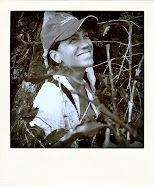 The first time I was in the Amazon I was a mere 24 years old and I was very pregnant. The year was 1991 and I had recently married my husband, who is not only much older and experienced than me, but who also had been a jungle explorer for over 20 years. To make matters worse, this was my first ever trip outside Mexico, Canada or the US and I had never been to an Indian village. The village we were visiting was literally in the middle of nowhere. I remember the shock of arriving at the frontier town of Rendecao, where our small Cessna had to stop to refuel before heading into the heart of the Amazon. The dirty, lawless, dusty town where a bunch of garimpeiros or illegal gold miners hung out with prostitutes, drunken loggers and a handful of raggedy looking Indians truly seemed like a scene out of Dante’s Inferno.
The first time I was in the Amazon I was a mere 24 years old and I was very pregnant. The year was 1991 and I had recently married my husband, who is not only much older and experienced than me, but who also had been a jungle explorer for over 20 years. To make matters worse, this was my first ever trip outside Mexico, Canada or the US and I had never been to an Indian village. The village we were visiting was literally in the middle of nowhere. I remember the shock of arriving at the frontier town of Rendecao, where our small Cessna had to stop to refuel before heading into the heart of the Amazon. The dirty, lawless, dusty town where a bunch of garimpeiros or illegal gold miners hung out with prostitutes, drunken loggers and a handful of raggedy looking Indians truly seemed like a scene out of Dante’s Inferno.
As debilitating as Redencao was to my pregnant disposition, I was utterly unprepared for the village of Aukre. After a three-hour long flight over unbroken rainforest we landed on a grassy airstrip located next to the circular opening where the village sat. Although Russ, my husband, had prepared me for the welcoming, I was still completely taken aback by the hundred or so people who came to greet the airplane.
Imagine that you live in an isolated village in the Amazon and the only supplies that ever reach you come in a sporadic Cessna, of course you too would run for the airstrip any time an aircraft approached town! The painted bodies, the toothless grins, the smell of sweat were almost too much! I was in what anthropologists call cultural shock.
Over the following years I have been lucky to visit many other Indian villages, but I have to say that to this day, Aukre is one of the most traditional places I have ever been to. The men do wear basketball shorts, but they seldom wear shirts, and many of them still wear feather cokais, or headdresses made of colorful macaw and parrot feathers. They are also never too far apart from their trusty bordunas – the traditional wooden war club.
 Many of the women wear what in the Amazon is known as the Missionary dress, a shapeless number that resembles more a sack of potatoes than a dress, and has no charm or shape –with the exception of a tiny (and largely useless) pocket on one side. Every Indian woman wears one and their only redeeming feature is that they come in all sorts of bright and cheery colors. The children, however, run around completely naked and wearing no shoes. When I visited Aukre I already traveled extensively in some of the poorest parts of my native Mexico, but I had never seen so many naked children. What I initially took as a sign of poverty, eventually revealed itself as a matter of pragmatism, as Indian children are like fish and they spend most of the time swimming and splashing in the river (there is always a river next to an Indian village….or is it the other way around?).
Many of the women wear what in the Amazon is known as the Missionary dress, a shapeless number that resembles more a sack of potatoes than a dress, and has no charm or shape –with the exception of a tiny (and largely useless) pocket on one side. Every Indian woman wears one and their only redeeming feature is that they come in all sorts of bright and cheery colors. The children, however, run around completely naked and wearing no shoes. When I visited Aukre I already traveled extensively in some of the poorest parts of my native Mexico, but I had never seen so many naked children. What I initially took as a sign of poverty, eventually revealed itself as a matter of pragmatism, as Indian children are like fish and they spend most of the time swimming and splashing in the river (there is always a river next to an Indian village….or is it the other way around?).In any case, I was so exhausted and suffering from bouts of morning sickness that I remember very little of what happened over the next few days. What I do remember is that my husband, an expert at this kind of experience (being an Anthropologist with a PhD from Harvard!) had brought stuff that the Indians wanted to trade: cigarettes, sugar, bright red cloth and several pounds of colorful beads. The purpose of the trading had to do with far more than a simple exercise in friendship; it was in fact a diplomatic endeavor that would eventually lead to a partnership between one of the world’s largest conservation groups, and one of the best politically-organized indigenous nations.

I will expand on the politics of conservation and indigenous people in future blogs. For now, I simply want to say that having that experience completely changed my life. Although I remember most vividly the “uncomfortable” portions of our visit….how I got sick when I accompanied some of the young men on a fishing expedition and couldn’t hold in my breakfast once they started throwing large, bloody fish (speared right through using a bow and arrow) into the bottom of the canoe. The smell of the fish, which by the way kept flapping in a pool of their own blood, much to my disgust and the indifference of the Indians, and the heat of the Amazonian midday sun, were enough to put me in my hammock for the rest of the day! I also remember the surprising chill of the Amazonian night. I spent my first ever night in a hammock shivering in nothing more than a pair of shorts and a tee-shirt. I had packed nothing warm and although I layered every other pair of shorts and tee-shirts I had brought, I still didn’t manage to be warm.

I mostly remember, however, an afternoon spent sitting in the shade of a large tree with the chief’s wife. I could speak no Kayapo and she spoke no English (neither of us spoke any Portuguese either, for that matter). She prepared a mushy substance using the pulp of a fruit mixed in with charcoal and with it she covered my legs, my arms and my pregnant belly with black designs. She kept repeating meikomene, which years later I discovered means “you are ok” in Kayapo.
In any case, it was not the amazing dances the women performed to thank us for bringing beads, or the colorful feather headdresses, or the evenings spent talking by the Indian campfire that I remember most. What stuck in my mind, was the gentle attitude of an Indian woman who sensed how frightened and uncomfortable I was and tried to make me feel better.
It is the common humanity we share with other cultures that attracts me most to indigenous people. It is not how different we are, but how similar we are that continues to fascinate me today.








I want to thank Jenny Nichols, my director of multimedia and field producer. She is the one who makes all of this happen. Thanks Jenny!
ReplyDelete